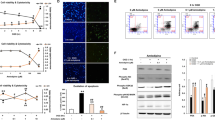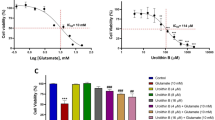Abstract
Overproduction of nitric oxide (NO) plays an important role in glutamate-induced excitotoxicity. Asymmetric dimethylarginine (ADMA) is an endogenous nitric oxide synthase (NOS) inhibitor. The aim of this study is to explore whether ADMA antagonizes the excitotoxicity of glutamate to neuronal cells and the underlying molecular mechanisms. In this work, we investigated the effects of ADMA on glutamate-induced toxicity in neuronal cells by studying PC12 cells, a clonal rat pheochromocytoma cell line. We show that ADMA obviously protects PC12 cells against glutamate-induced cytotoxicity and apoptosis. We also found that ADMA treatment results in prevention of glutamate-induced mitochondrial membrane potential loss and caspase-3 activation. Moreover, ADMA prevents glutamate-caused down-regulation of bcl-2 protein expression. These results indicate that ADMA protects against glutamate-induced apoptosis and excitotoxicity and the underlying mechanism may be involved in preservation of mitochondrial function by up-regulating the expression of bcl-2. Our study suggests a promising future of ADMA-based therapies for neuropathologies associated with an excess of NO.





Similar content being viewed by others
References
Aarts MM, Tymianski M (2003) Novel treatment of excitotoxicity: targeted disruption of intracellular signalling from glutamate receptors. Biochem Pharmacol 66:877–886
Ankarcrona M, Dypbukt JM, Bonfoco E, Zhivotovsky B, Orrenius S, Lipton SA, Nicotera P (1995) Glutamate-induced neuronal death: a succession of necrosis or apoptosis depending on mitochondrial function. Neuron 15:961–973
Beltowski J, Kedra A (2006) Asymmetric dimethylarginine (ADMA) as a target for pharmacotherapy. Pharmacol Rep 58:159–178
Bonfoco E, Krainc D, Ankarcrona M, Nicotera P, Lipton SA (1995) Apoptosis and necrosis: two distinct events induced, respectively, by mild and intense insults with N-methyl-d-aspartate or nitric oxide/superoxide in cortical cell cultures. Proc Natl Acad Sci USA 92:7162–7166
Brecht S, Gelderblom M, Srinivasan A, Mielke K, Dityateva G, Herdegen T (2001) Caspase-3 activation and DNA fragmentation in primary hippocampal neurons following glutamate excitotoxicity. Mol Brain Res 94:25–34
Choi DW, Koh JY, Peters S (1988) Pharmacology of glutamate neurotoxicity in cortical cell culture: attenuation by NMDA antagonists. J Neurosci 8:185–196
Coleman M (2005) Axon degeneration mechanisms: commonality amid diversity. Nat Rev Neurosci 6:889–898
Dobrek L, Thor P (2011) Glutamate NMDA receptors in pathophysiology and pharmacotherapy of selected nervous system diseases. Postepy Hig Med Dosw (Online) 65:338–346
Dong XX, Wang Y, Qin ZH (2009) Molecular mechanisms of excitotoxicity and their relevance to pathogenesis of neurodegenerative diseases. Acta Pharmacol Sin 30:379–387
Duan WG, Shang J, Jiang ZZ, Yao JC, Yun Y, Yan M, Shu B, Lin Q, Yu ZP, Zhang LY (2009) Rho kinase inhibitor Y-27632 down-regulates norepinephrine synthesis and release in PC12 cells. Basic Clin Pharmacol Toxicol 104:434–440
Fiskum G, Starkov A, Polster BM, Chinopoulos C (2003) Mitochondrial mechanisms of neural cell death and neuroprotective interventions in Parkinson's disease. Ann N Y Acad Sci 991:111–119
Fukui M, Song JH, Choi J, Choi HJ, Zhu BT (2009) Mechanism of glutamate-induced neurotoxicity in HT22 mouse hippocampal cells. Eur J Pharmacol 617:1–11
Hamilton NB, Attwell D (2010) Do astrocytes really exocytose neurotransmitters? Nat Rev Neurosci 11:227–238
Johnson LV, Walsh ML, Bockus BJ, Chen LB (1981) Monitoring of relative mitochondrial membrane potential in living cells by fluorescence microscopy. J Cell Biol 88:526–535
Kataria H, Wadhwa R, Kaul SC, Kaur G (2012) Water extract from the leaves of Withania somnifera protect RA differentiated C6 and IMR-32 cells against glutamate-induced excitotoxicity. PLoS One 7:e37080
Knott AB, Bossy-Wetzel E (2009) Nitric oxide in health and disease of the nervous system. Antioxid Redox Signal 11:541–554
Knott AB, Perkins G, Schwarzenbacher R, Bossy-Wetzel E (2008) Mitochondrial fragmentation in neurodegeneration. Nat Rev Neurosci 9:505–518
Lau A, Tymianski M (2010) Glutamate receptors, neurotoxicity and neurodegeneration. Pflugers Archiv: European J Physiol 460:525–542
Li R, Kong Y, Ladisch S (1998) Nerve growth factor-induced neurite formation in PC12 cells is independent of endogenous cellular gangliosides. Glycobiology 8:597–603
Lipton SA, Rosenberg PA (1994) Excitatory amino acids as a final common pathway for neurologic disorders. N Engl J Med 330:613–622
Nakamura T, Lipton SA (2007) S-Nitrosylation and uncompetitive/fast off-rate (UFO) drug therapy in neurodegenerative disorders of protein misfolding. Cell Death Differ 14:1305–1314
Petronilli V, Penzo D, Scorrano L, Bernardi P, Di Lisa F (2001) The mitochondrial permeability transition, release of cytochrome c and cell death. Correlation with the duration of pore openings in situ. J Biol Chem 276:12030–12034
Rajendra W, Armugam A, Jeyaseelan K (2004) Neuroprotection and peptide toxins. Brain Res Rev 45:125–141
Shearman MS, Hawtin SR, Tailor VJ (1995) The intracellular component of cellular 3-(4,5-dimethylthiazol-2-yl)-2, 5-diphenyltetrazolium bromide (MTT) reduction is specifically inhibited by beta-amyloid peptides. J Neurochem 65:218–227
Tang XQ, Li YJ, Zhao J, Shen XT, Yang CT, Fan LL, Hu B, Liao DF (2010) Neuroprotective effect of asymmetric dimethylarginine against 1-methyl-4-phenylpyridinium ion-induced damage in PC12 cells. Clin Exp Pharmacol Physiol 37:530–535
Teerlink T, Luo Z, Palm F, Wilcox CS (2009) Cellular ADMA: regulation and action. Pharmacol Res 60:448–460
Tenneti L, Lipton SA (2000) Involvement of activated caspase-3-like proteases in N-methyl-d-aspartate-induced apoptosis in cerebrocortical neurons. J Neurochem 74:134–142
Vallance P, Leone A, Calver A, Collier J, Moncada S (1992) Accumulation of an endogenous inhibitor of nitric oxide synthesis in chronic renal failure. Lancet 339:572–575
Wang S, Hu CP, Jiang DJ, Peng J, Zhou Z, Yuan Q, Nie SD, Jiang JL, Li YJ, Huang KL (2009) All-trans retinoic acid inhibits cobalt chloride-induced apoptosis in PC12 cells: role of the dimethylarginine dimethylaminohydrolase/asymmetric dimethylarginine pathway. J Neurosci Res 87:1938–1946
Wu LY, Ding AS, Zhao T, Ma ZM, Wang FZ, Fan M (2004) Involvement of increased stability of mitochondrial membrane potential and overexpression of Bcl-2 in enhanced anoxic tolerance induced by hypoxic preconditioning in cultured hypothalamic neurons. Brain Res 999:149–154
Yang X, Wang Y, Luo J, Liu S, Yang Z (2011) Protective effects of YC-1 against glutamate induced PC12 cell apoptosis. Cell Mol Neurobiol 31:303–311
Yang EJ, Min JS, Ku HY, Choi HS, Park MK, Kim MK, Song KS, Lee DS (2012) Isoliquiritigenin isolated from Glycyrrhiza uralensis protects neuronal cells against glutamate-induced mitochondrial dysfunction. Biochem Biophys Res Commun 421:658–664
Author information
Authors and Affiliations
Corresponding author
Rights and permissions
About this article
Cite this article
Wang, XY., Zhao, J. & Yang, HW. Asymmetrical Dimethylarginine Antagonizes Glutamate-Induced Apoptosis in PC12 Cells. J Mol Neurosci 49, 89–95 (2013). https://doi.org/10.1007/s12031-012-9897-z
Received:
Accepted:
Published:
Issue Date:
DOI: https://doi.org/10.1007/s12031-012-9897-z




